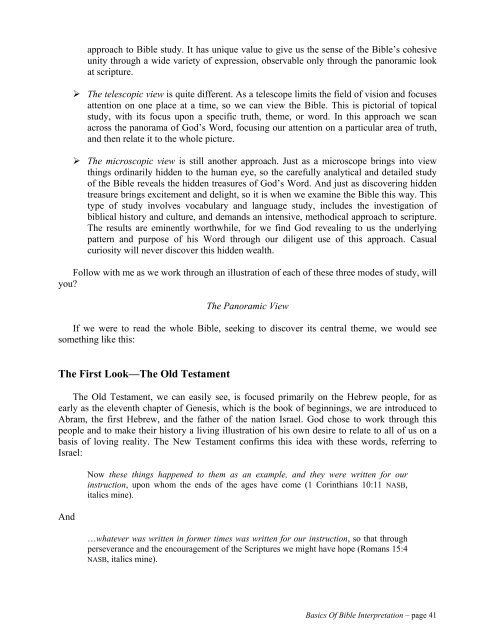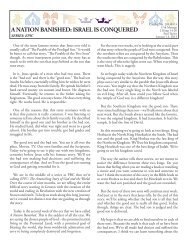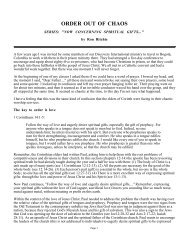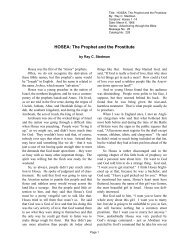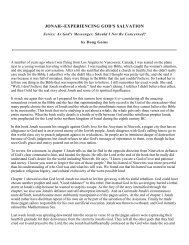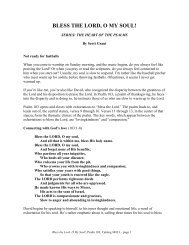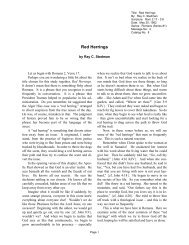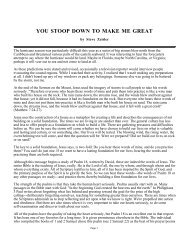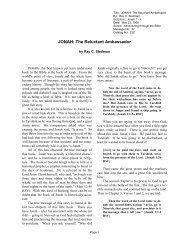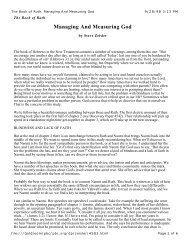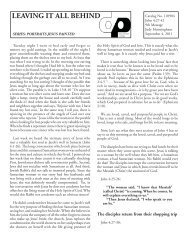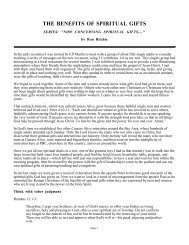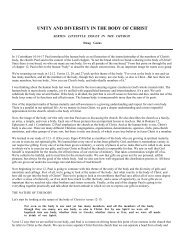Basics of Bible Interpretation - RayStedman.org
Basics of Bible Interpretation - RayStedman.org
Basics of Bible Interpretation - RayStedman.org
Create successful ePaper yourself
Turn your PDF publications into a flip-book with our unique Google optimized e-Paper software.
approach to <strong>Bible</strong> study. It has unique value to give us the sense <strong>of</strong> the <strong>Bible</strong>’s cohesive<br />
unity through a wide variety <strong>of</strong> expression, observable only through the panoramic look<br />
at scripture.<br />
‣ The telescopic view is quite different. As a telescope limits the field <strong>of</strong> vision and focuses<br />
attention on one place at a time, so we can view the <strong>Bible</strong>. This is pictorial <strong>of</strong> topical<br />
study, with its focus upon a specific truth, theme, or word. In this approach we scan<br />
across the panorama <strong>of</strong> God’s Word, focusing our attention on a particular area <strong>of</strong> truth,<br />
and then relate it to the whole picture.<br />
‣ The microscopic view is still another approach. Just as a microscope brings into view<br />
things ordinarily hidden to the human eye, so the carefully analytical and detailed study<br />
<strong>of</strong> the <strong>Bible</strong> reveals the hidden treasures <strong>of</strong> God’s Word. And just as discovering hidden<br />
treasure brings excitement and delight, so it is when we examine the <strong>Bible</strong> this way. This<br />
type <strong>of</strong> study involves vocabulary and language study, includes the investigation <strong>of</strong><br />
biblical history and culture, and demands an intensive, methodical approach to scripture.<br />
The results are eminently worthwhile, for we find God revealing to us the underlying<br />
pattern and purpose <strong>of</strong> his Word through our diligent use <strong>of</strong> this approach. Casual<br />
curiosity will never discover this hidden wealth.<br />
Follow with me as we work through an illustration <strong>of</strong> each <strong>of</strong> these three modes <strong>of</strong> study, will<br />
you?<br />
The Panoramic View<br />
If we were to read the whole <strong>Bible</strong>, seeking to discover its central theme, we would see<br />
something like this:<br />
The First Look—The Old Testament<br />
The Old Testament, we can easily see, is focused primarily on the Hebrew people, for as<br />
early as the eleventh chapter <strong>of</strong> Genesis, which is the book <strong>of</strong> beginnings, we are introduced to<br />
Abram, the first Hebrew, and the father <strong>of</strong> the nation Israel. God chose to work through this<br />
people and to make their history a living illustration <strong>of</strong> his own desire to relate to all <strong>of</strong> us on a<br />
basis <strong>of</strong> loving reality. The New Testament confirms this idea with these words, referring to<br />
Israel:<br />
And<br />
Now these things happened to them as an example, and they were written for our<br />
instruction, upon whom the ends <strong>of</strong> the ages have come (1 Corinthians 10:11 NASB,<br />
italics mine).<br />
…whatever was written in former times was written for our instruction, so that through<br />
perseverance and the encouragement <strong>of</strong> the Scriptures we might have hope (Romans 15:4<br />
NASB, italics mine).<br />
<strong>Basics</strong> Of <strong>Bible</strong> <strong>Interpretation</strong> – page 41


